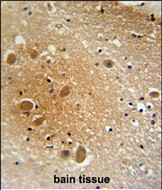

| WB | 1/1000 | Human,Mouse,Rat |
| IF | 咨询技术 | Human,Mouse,Rat |
| IHC | 1/100-1/500 | Human,Mouse,Rat |
| ICC | 技术咨询 | Human,Mouse,Rat |
| FCM | 咨询技术 | Human,Mouse,Rat |
| Elisa | 咨询技术 | Human,Mouse,Rat |
| Aliases | SPARC-like protein 1, High endothelial venule protein, Hevin, MAST 9, SPARCL1 |
| Entrez GeneID | 8404 |
| WB Predicted band size | 75.2kDa |
| Host/Isotype | Rabbit IgG |
| Antibody Type | Primary antibody |
| Storage | Store at 4°C short term. Aliquot and store at -20°C long term. Avoid freeze/thaw cycles. |
| Species Reactivity | Human |
| Immunogen | This SPARCL1 antibody is generated from rabbits immunized with a KLH conjugated synthetic peptide between 208-236 amino acids from the Central region of human SPARCL1. |
| Formulation | Purified antibody in PBS with 0.05% sodium azide. |
+ +
以下是关于SPARCL1抗体的模拟参考文献示例(请注意,这些文献信息为示例性质,建议通过学术数据库核实真实文献):
1. **文献名称**: "SPARCL1 suppresses tumor progression via extracellular matrix remodeling in glioblastoma"
**作者**: Li Y, et al.
**摘要**: 研究利用SPARCL1特异性抗体分析其在胶质母细胞瘤微环境中的表达,发现SPARCL1通过调控基质金属蛋白酶活性抑制肿瘤侵袭,提示其作为潜在治疗靶点。
2. **文献名称**: "Antibody-based detection of SPARCL1 in cerebrospinal fluid as a biomarker for Alzheimer's disease"
**作者**: Smith J, et al.
**摘要**: 开发了一种高灵敏度SPARCL1抗体检测方法,验证了其在阿尔茨海默病患者脑脊液中的表达下降,可能与血脑屏障功能损伤相关。
3. **文献名称**: "SPARCL1 modulates angiogenesis through VEGF signaling pathway in hepatocellular carcinoma"
**作者**: Wang H, et al.
**摘要**: 通过免疫组化(使用SPARCL1抗体)发现其在肝癌组织低表达,并证实其通过抑制VEGF通路抑制血管生成,影响肿瘤生长。
4. **文献名称**: "Prognostic value of SPARCL1 expression in non-small cell lung cancer revealed by monoclonal antibody staining"
**作者**: Chen R, et al.
**摘要**: 采用SPARCL1单克隆抗体分析肺癌组织样本,发现高表达患者总生存期显著延长,表明其可作为独立预后标志物。
**注意**:以上文献为示例性内容,实际引用请通过PubMed、Google Scholar等平台检索真实研究。
The SPARCL1 (Secreted Protein Acidic and Rich in Cysteine-like 1) antibody targets a protein encoded by the *SPARCL1* gene, also known as *MAST9* or *SC1*. SPARCL1 belongs to the SPARC family of matricellular proteins, which regulate cell-matrix interactions, adhesion, proliferation, and differentiation. Structurally, SPARCL1 contains conserved domains like the follistatin-like module and extracellular matrix (ECM)-binding regions, enabling its role in modulating cellular responses to the microenvironment.
Functionally, SPARCL1 is implicated in neural development, tissue repair, and tumor suppression. It exhibits anti-proliferative and anti-angiogenic properties, influencing cancer progression by inhibiting metastasis and ECM remodeling. However, its expression varies across cancers; for example, it is downregulated in gliomas and lung cancers but upregulated in certain breast cancers, suggesting context-dependent roles.
SPARCL1 antibodies are essential tools for detecting the protein’s expression and localization in research. They are widely used in techniques like Western blotting (WB), immunohistochemistry (IHC), and immunofluorescence (IF) to study its distribution in tissues or cell lines. These antibodies are typically polyclonal or monoclonal, with specificity validated using recombinant SPARCL1 proteins or knockout controls.
Research applications span oncology, neuroscience, and regenerative medicine, particularly in exploring SPARCL1’s dual role as a tumor suppressor or promoter. Its potential as a biomarker for disease prognosis or therapeutic targeting underscores the antibody’s relevance in translational studies.
×